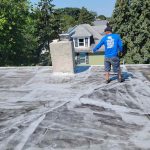Summer in New Jersey is a time for enjoying warm weather and outdoor activities, but it also brings the risk of severe storms. Thunderstorms, heavy rainfall, high winds, and even hail can take a toll on your roof, potentially leading to costly damage if not properly addressed. As a homeowner, understanding the impact of summer storms on your roof and knowing how to prepare can help you protect your property and ensure your roof remains in top condition. In this blog, Super Duty Roofing shares essential tips on how to prepare your roof for summer storms and what to do if your roof sustains damage.
Understanding the Risks of Summer Storms
Summer storms can be unpredictable and powerful, often arriving with little warning. These storms can include a combination of strong winds, heavy rain, hail, and lightning, all of which can cause significant damage to your roof. Here’s how each element can impact your roofing system:
- High Winds: Strong winds can lift and tear off shingles, leaving your roof vulnerable to water infiltration. Winds can also cause tree branches and other debris to fall onto your roof, leading to punctures or other structural damage.
- Heavy Rain: Intense rainfall can overwhelm your roof’s drainage system, leading to water pooling and leaks. Over time, excessive moisture can weaken the roofing materials and cause mold and mildew growth.
- Hail: Hailstones can range in size from small pellets to large chunks of ice. When hail impacts your roof, it can crack or bruise shingles, compromising their ability to protect your home from water.
- Lightning: While rare, lightning strikes can cause severe damage to roofs, especially if your home is the tallest structure in the area. A direct hit can lead to fires or structural damage.
Preparing Your Roof for Summer Storms
Taking proactive steps to prepare your roof before storm season can minimize the risk of damage and help you avoid costly repairs. Here are some key preparation tips:
- Inspect Your Roof Regularly: Start with a thorough inspection of your roof. Look for loose or missing shingles, damaged flashing, and any signs of wear and tear. Pay close attention to areas around chimneys, vents, and skylights, as these are common points of entry for water.
- Trim Overhanging Branches: Trees near your home can pose a significant risk during storms. Trim back any overhanging branches that could fall onto your roof during high winds. This simple step can prevent punctures and other damage caused by falling debris.
- Clean Gutters and Downspouts: Ensure that your gutters and downspouts are clear of leaves, twigs, and other debris. Clogged gutters can cause water to back up and overflow, leading to water damage on your roof and around your foundation.
- Check for Loose or Damaged Flashing: Flashing is essential for sealing joints and preventing water from seeping into your home. Inspect the flashing around chimneys, vents, and other roof penetrations for signs of damage or looseness. Repair or replace any compromised sections to maintain a watertight seal.
- Consider Roof Reinforcement: If your roof is older or if you live in an area prone to severe storms, consider reinforcing it with additional fasteners or hurricane straps. These measures can help secure your roof during high winds and reduce the risk of damage.
What to Do After a Summer Storm
Even with the best preparation, your roof may still sustain damage during a summer storm. Knowing how to respond quickly can help minimize further damage and expedite the repair process:
- Inspect Your Roof for Damage: After a storm, carefully inspect your roof for signs of damage. Look for missing shingles, dented or cracked shingles from hail, and any debris that may have fallen onto your roof. If you’re unsure about the extent of the damage, consider hiring a professional roofing contractor to conduct a thorough inspection.
- Document the Damage: If you notice any damage, document it with photographs and detailed notes. This documentation will be helpful if you need to file an insurance claim.
- Make Temporary Repairs: If possible, make temporary repairs to prevent further water damage. For example, you can cover exposed areas with a tarp to keep out rain until professional repairs can be made.
- Contact a Roofing Professional: Reach out to a trusted roofing contractor as soon as possible to assess the damage and begin repairs. Prompt action can prevent small issues from becoming larger, more expensive problems.
Conclusion
Summer storms can pose a significant threat to your roof, but with proper preparation and prompt action, you can protect your home and minimize damage. By inspecting your roof regularly, trimming overhanging branches, cleaning gutters, and addressing any vulnerabilities, you can ensure that your roof is ready to withstand the challenges of summer weather. If your roof does sustain damage, don’t hesitate to Contact Super Duty Roofing for expert repairs and peace of mind. We’re here to help you keep your home safe and secure, no matter what the weather brings.




















